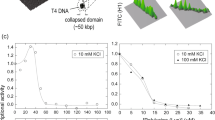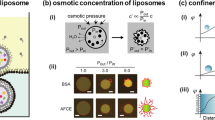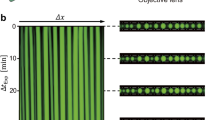Abstract
An aqueous two phase system (ATPS) is composed of binary hydrophilic polymers, for example, polyethylene glycol (PEG) and dextran, under an immiscible condition, and can also exhibit micro-segregation to produce cell-sized microcompartments like water-in-water microdroplets. Without membranes, interestingly, the microdroplet can serve as a micro-vessel (reactor) that contains various biochemical macromolecules like DNAs and proteins. We here present that PEG/dextran ATPS micro-segregation can provide an effective soft boundary to separate these biochemical macromolecules from the external environment. Trapped DNAs and proteins were concentrated inside such small spaces, and therefore, their interaction could be highly promoted to cause passive aggregation and controlled cross-linking if a certain cross-linker was added. We believe that the ATPS microdroplets might be associated with complicated structures and functions of living cells.
Similar content being viewed by others
References
P. Walde, K. Cosentino, H. Engel and Pasquale Stano, ChemBioChem, 11, 848 (2010).
K. Tsumoto, S. M. Nomura, Y. Nakatani and K. Yoshikawa, Langmuir, 17, 7225 (2001).
S. M. Nomura, K. Tsumoto, T. Hamada, K. Akiyoshi, Y. Nakatani and K. Yoshikawa, ChemBioChem, 4, 1172 (2003).
Z. Nourian, W. Roelofsen, C. Danelon, Angew. Chem. Int. Ed. Engl., 51, 3114 (2012).
H. Soga, S. Fujii, T. Yomo, Y. Kato, H. Watanabe, T. Matsuura, ACS Synth. Biol., 3, 372 (2014).
T. Shimizu, T. Mori, M. Tomita and K. Tsumoto, Langmuir, 30, 554 (2014).
D. M. Mitrea and R. W. Kriwacki, Cell Commun. Signal., 14, 1 (2016).
M. Feric, N. Vaidya, T. S. Harmon, D. M. Mitrea, L. Zhu, T. M. Richardson, R. W. Kriwacki, R. V. Pappu, C. P. Brangwynne, Cell, 165, 1686 (2016).
P.-Å. Albertsson, “Partition of Cell Particles and Macromolecules,” 2nd ed., (Wiley-Interscience, 1971) pp. 12–321.
W. M. Aumiller, Jr., and C. D. Keating, Adv. Colloid Interface Sci., 239, 75 (2017).
K. Tsumoto, M. Arai, N. Nakatani, S. N. Watanabe and K. Yoshikawa, Life (Basel), 5, 459 (2015).
H. Toyama, K. Yoshikawa and H. Kitahata, Phys. Rev. E, 78, 060801 (2008).
Y. Wang and O. Annunziata, Langmuir, 24, 2799 (2008).
H. J. Lee, H. H. Park, J. A. Kim, J. H. Park, J. Ryu, J. Choi, J. Lee, W. J. Rhee and T. H. Park, Biomaterials, 35, 1696 (2014).
Author information
Authors and Affiliations
Rights and permissions
About this article
Cite this article
Tsumoto, K., Yoshikawa, K. The Aqueous Two Phase System (ATPS) Deserves Plausible Real-World Modeling for the Structure and Function of Living Cells. MRS Advances 2, 2407–2413 (2017). https://doi.org/10.1557/adv.2017.358
Published:
Issue Date:
DOI: https://doi.org/10.1557/adv.2017.358




